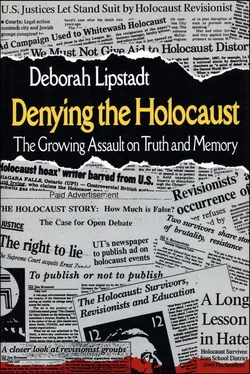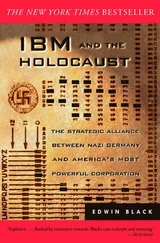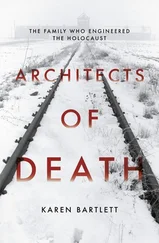For example, both the American and the British authors describe Eichmann’s assistant as “a nervous wreck and addicted to uncontrollable fits of sobbing for hours” (pp. 46, 11). In addition, Dr. M. Nyiszli, the author of Doctor at Auschwitz, is described in the American and the British versions as “apparently a mythical and invented figure” (pp. 118, 20). Nyiszli was a Jewish doctor who worked under the infamous Dr. Josef Mengele as a pathologist. His role is well established in documents and testimonies. There are numerous other examples of “shared” citations and paraphrasing. See, for example, the section on the International Committee of the Red Cross, “Letters of thanks which came pouring in from Jewish internees.” (pp. 99, 25). Compare also p. 98 with p. 24 and p. 101 with p. 25.
Scholars debate at what point in 1941 the Nazis decided to murder all the Jews in their sphere of influence. The prospect of having many millions of Jews, including those in the Soviet Union, under their rule when they overran that country led them to conclude that murder was the only “efficient” means of dealing with the Jewish “problem.” Intentionalists argue that the Nazis intended from the outset to eventually murder the Jews and that there was a high degree of consistency and orderly sequence in the Final Solution. Functionalists believe that there was no blueprint for the murder of the Jews but that the annihilation program was initially a means for the Nazis to emerge from a blind alley into which they had maneuvered themselves. Functionalists argue that in its first stages the murder program was improvised, and it proceeded in a haphazard fashion.
I do not intend to enter the debate between the intentionalists and the functionalists. Both groups essentially agree that the war and especially the invasion of the Soviet Union made the annihilation process possible—irrespective of when and how the idea originated. Until 1939 the Nazis tried to get rid of the Jews by pressuring them into emigration. After that time they forcibly extruded them. For an excellent summary of this entire debate see Michael R. Marrus, The Holocaust in History, (New York, 1989 [pbk.]), pp. 34–48.
Buber’s book contains a variety of historical flaws. I use her work not as a historical source but as an example of how deniers regularly falsify authors’ conclusions.
The American publication The Myth of the Six Million made the same claim about the ICRC report (p. 101).
Joachim C. Fest, Hitler (London, 1974).
The St. Louis was the German ship that was turned away from Cuba in May 1939 because the Cuban government had invalidated the landing certificates of the refugees on board. When the ship tried to land in Miami government officials denied permission.
In 1916 the Germans began to lose World War I. The National Socialists attributed this loss to a “stab in the back” administered by the Jews.
The most significant was its unprecedented nature.
In the spring of 1981 he left the IHR because of differences with the organization’s controlling power, Willis Carto. He spent most of the rest of his life until his death in 1991 engaged in a bitter and vitriolic fight with Carto and the IHR.
Various Jewish organizations with which Mermelstein consulted, including the ADL and the Simon Wiesenthal Center, suggested that he ignore the IHR’s challenge because participating would only give the deniers the attention they craved. He decided to proceed nonetheless.
In 1990 Mermelstein’s story was made into a television movie starring Leonard Nimoy.
Among the mailings distributed by his so-called Jewish Information Society is a grossly distorted sexually explicit cartoon depicting male and female elderly Jew. Both have large hooked noses. The woman, whose breasts droop down to her knees, has stubble on her chin and is smoking a cigarette. The man’s penis, which is erect, is supported by a splint, and his scrotum droops to his knees. The caption reads, “In spite of his feeble condition, Dr. Mengele was able to rejuvenate him and he is now proudly showing off his fine restoration to his beautiful, most anticipating, and sensuous looking sweetheart.”
In 1979 Carto turned control of the American Mercury over to Ned Touchstone, who had been on the Board of Policy of the Liberty Lobby at the same time as he served as editor of the journal published by the White Citizens Councils.
In bringing charges against Zundel the Canadian government joined what had begun as a private complaint. Sabrina Citron, a survivor of the Holocaust and a citizen of Canada, initiated the action against Zundel. Most Canadian Jewish organizations did not support her decision.
The jury found him guilty of spreading false information about the Holocaust but acquitted him on charges connected with “The West, War, and Islam.”
The London edition was entitled Auschwitz: The End of the Line: The Leuchter Report—The First Forensic Examination of Auschwitz. It contained a foreword by Irving.
Zundel was found guilty a second time and sentenced to nine months in jail. In 1992 the law under which Zundel had been charged was declared unconstitutional by the Canadian Supreme Court.
They showed him documentation regarding the design and fabrication of sophisticated ventilation systems that had been installed in the gas chambers. What purpose, they asked, would such a system have served in a morgue or crematorium?
He did the same thing with Otto Frank, Anne Frank’s father (see Appendix).
In the segment Leuchter took the film crew on a tour of the North Carolina chamber. The impression given viewers was that he had worked on this facility when, in fact, he had not. Prime Time Live (ABC-TV), May 10, 1990.
The Russian archives granted Irving permission to copy two microfiche plates, each of which held about forty-five pages of the diaries. Irving immediately violated his agreement, took many plates, transported them abroad, and had them copied without archival permission. There is serious concern in archival circles that he may have significantly damaged the plates when he did so, rendering them of limited use to subsequent researchers.
Irving believes Jews are “very foolish not to abandon the gas chamber theory while they still have time.” He “foresees [a] new wave of antisemitism” due to Jews’ exploitation of the Holocaust “myth.” C. C. Aronsfeld, “Holocaust ‘Revisionists’ Are Busy in Britain,” Midstream, Jan. 1993, p. 29.
Among the papers that accepted it, either as an ad or an op-ed column, were the University of Arizona, Cornell, Duke, the University of Georgia, Howard, the University of Illinois at Urbana-Champaign, Louisiana State, the University of Michigan, the University of Montana, Northwestern, Ohio State, Rutgers, Vanderbilt, Washington University, and the University of Washington.
Among those colleges rejecting the ad were Berkeley, Brown, the University of California at Santa Barbara, the University of Chicago, Dartmouth, Emory, Georgetown, Harvard, the University of Minnesota, the University of North Carolina, the University of Pennsylvania, Purdue, Rice, the University of Southern California, the University of Tennessee, the University of Texas (Austin), UCLA, the University of Virginia, the University of Wisconsin (Madison), and Yale.
Читать дальше












